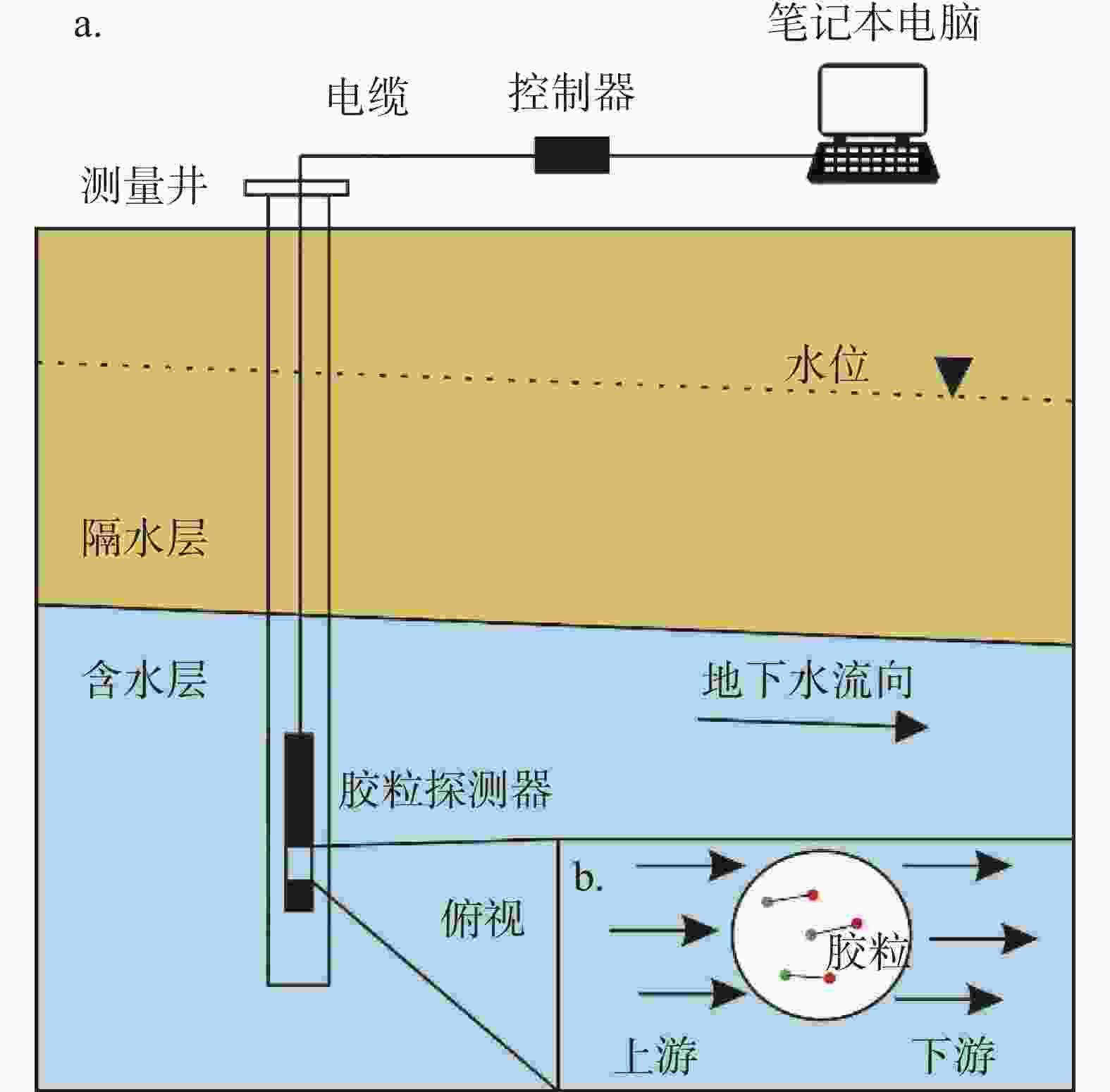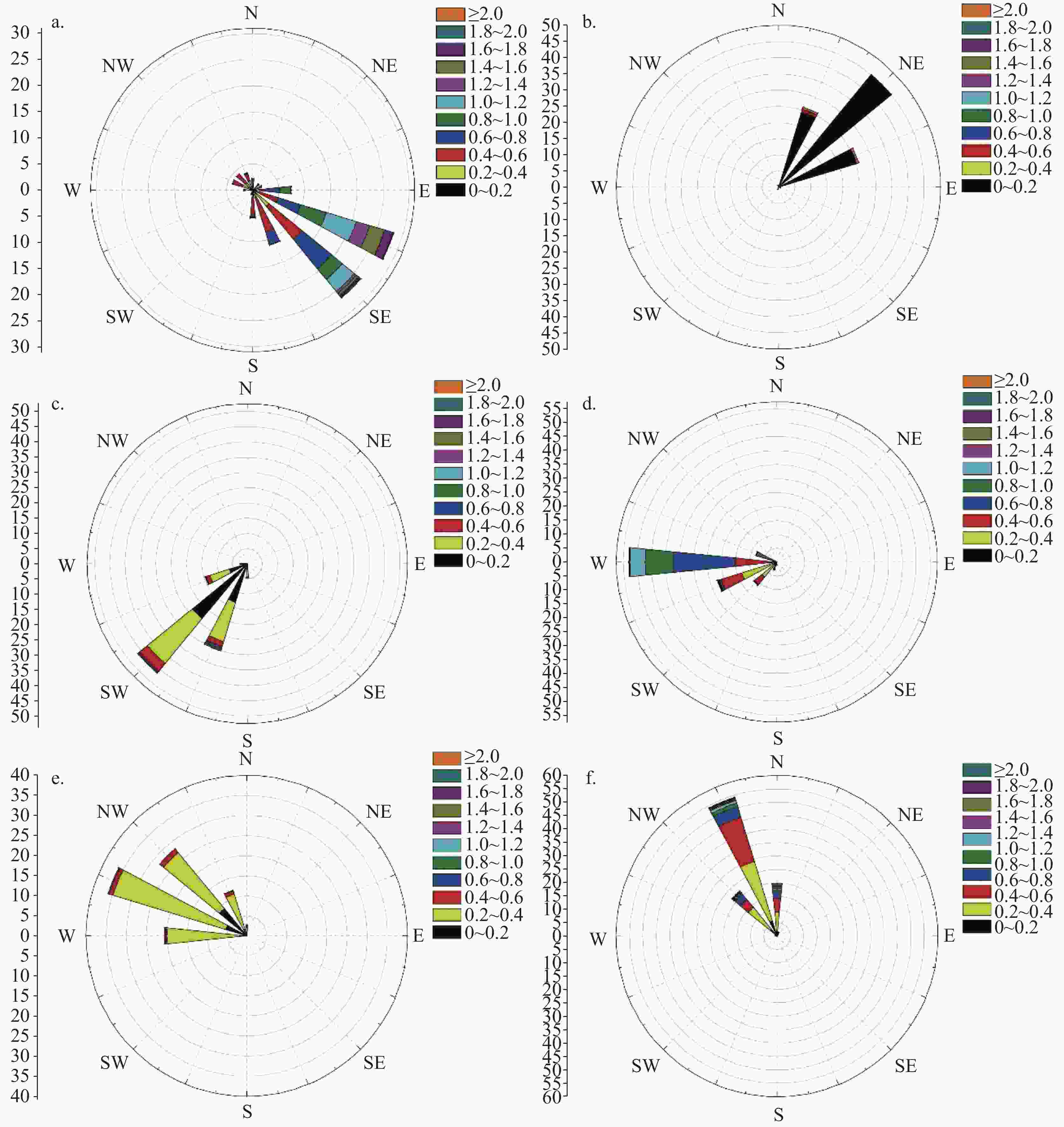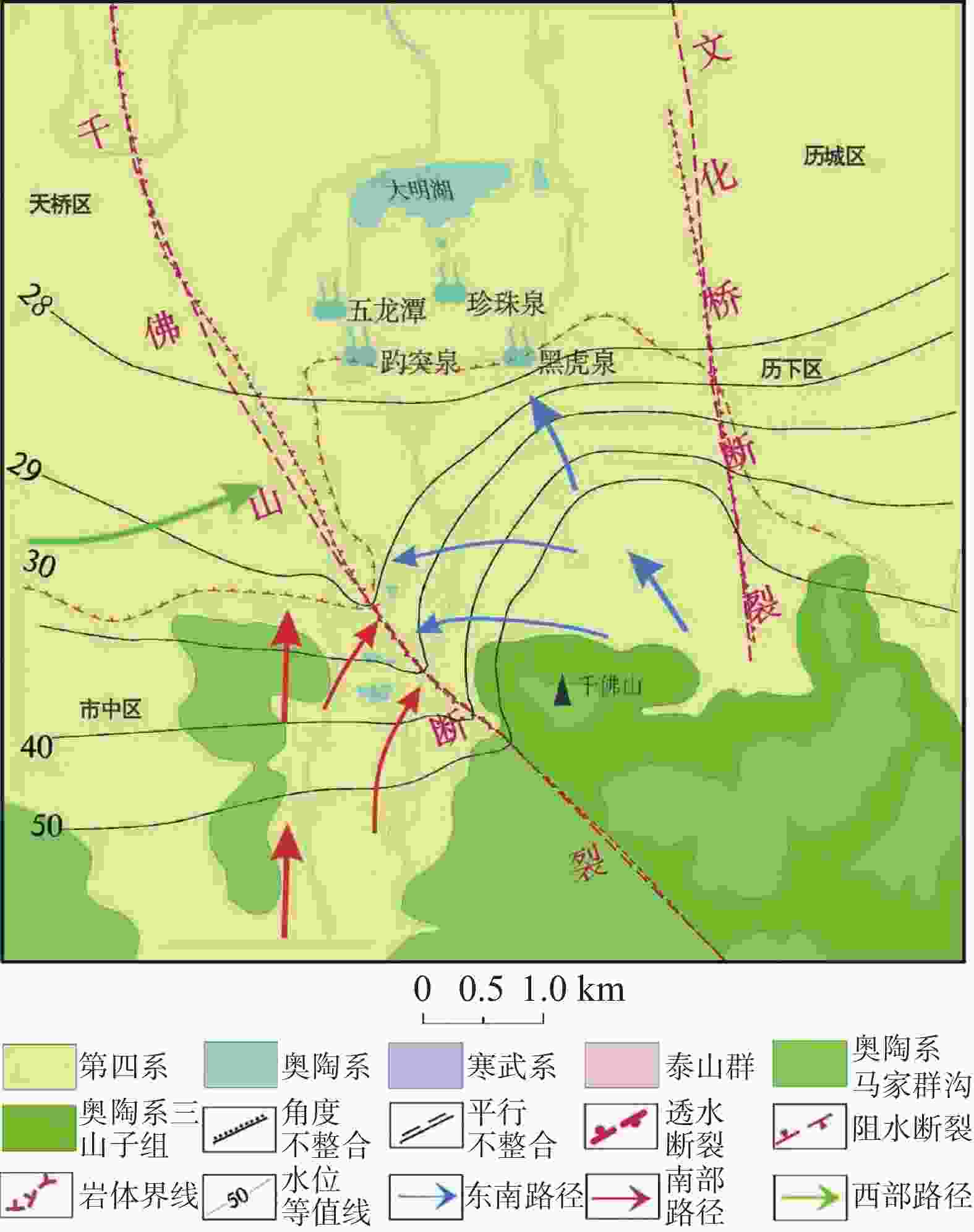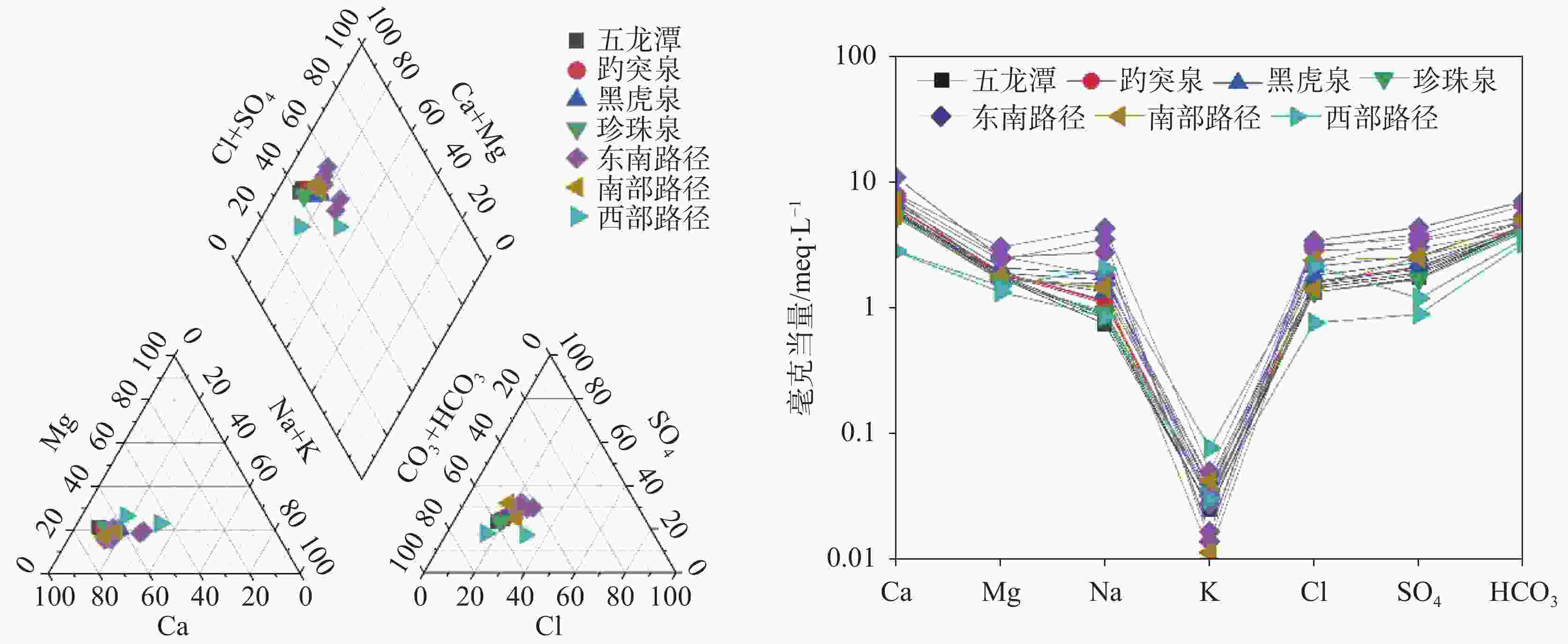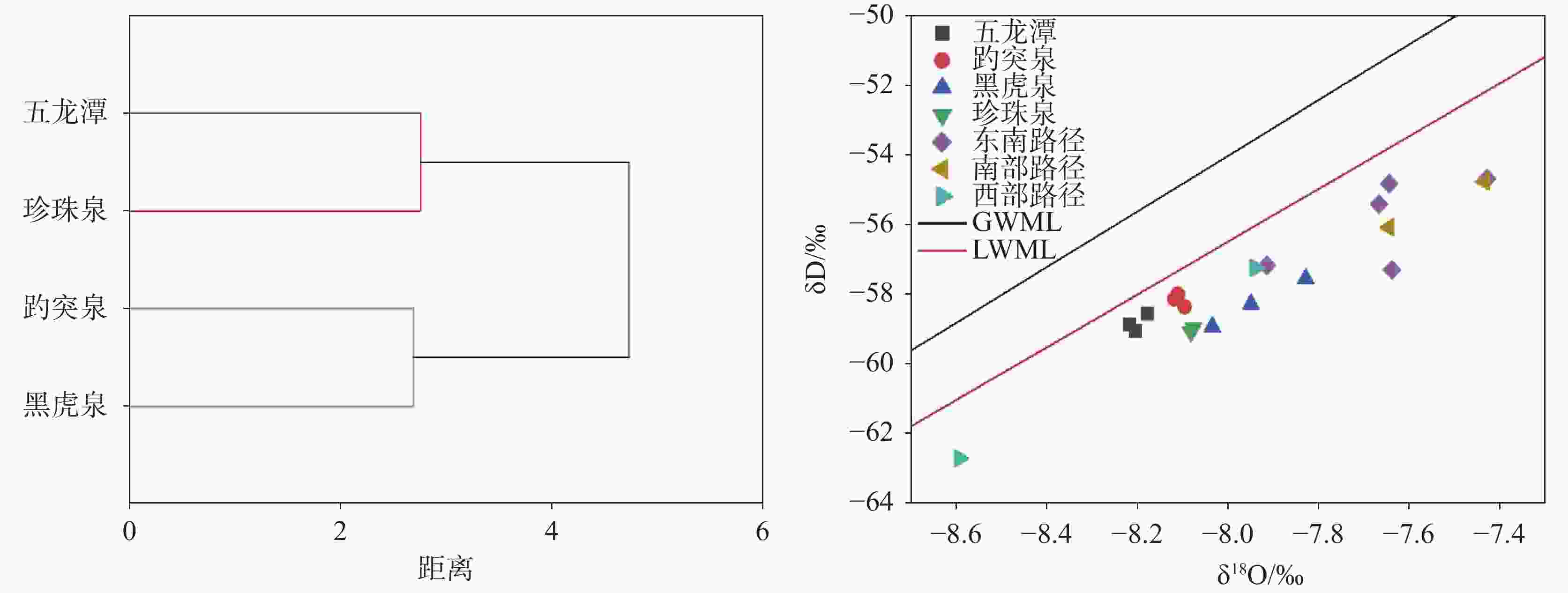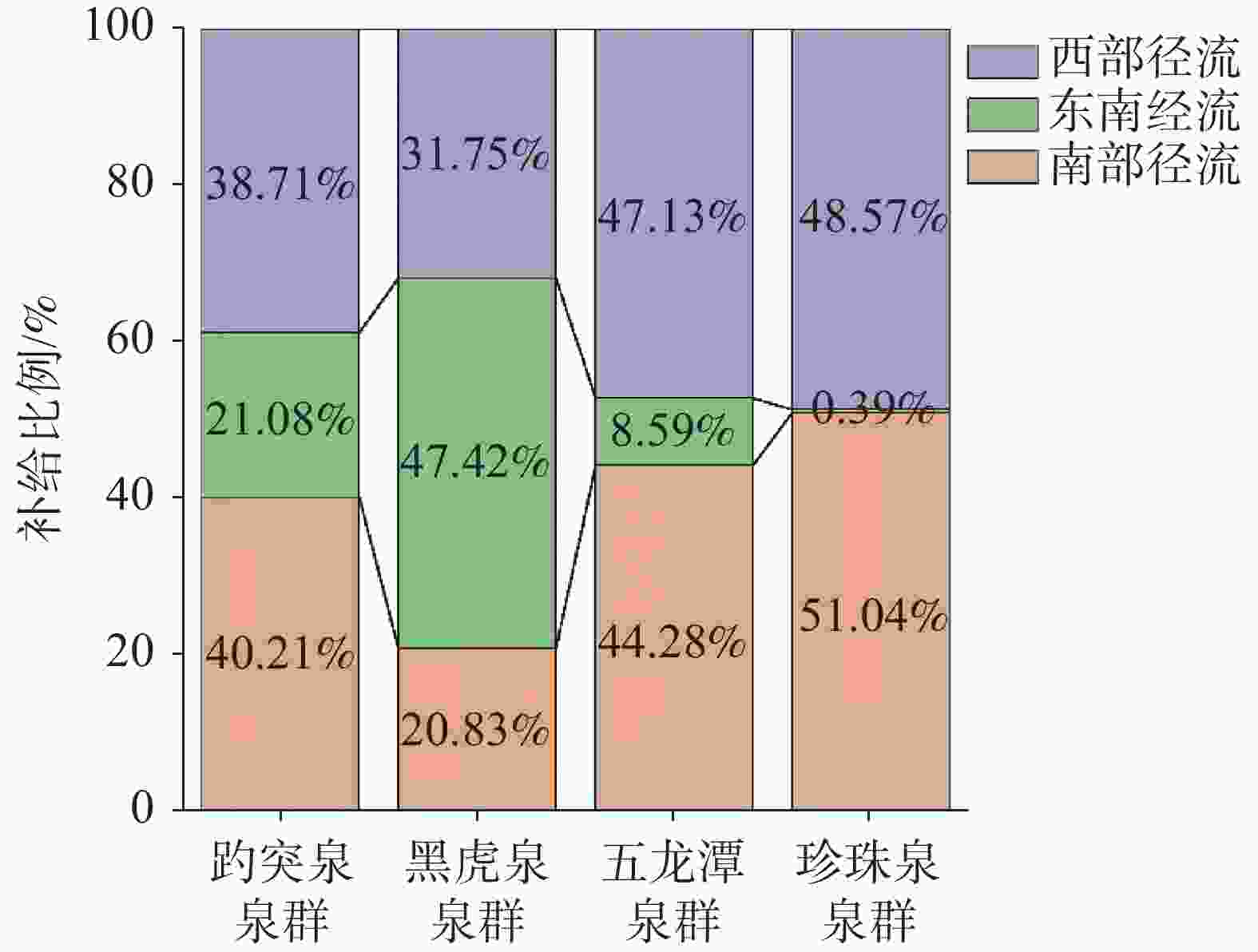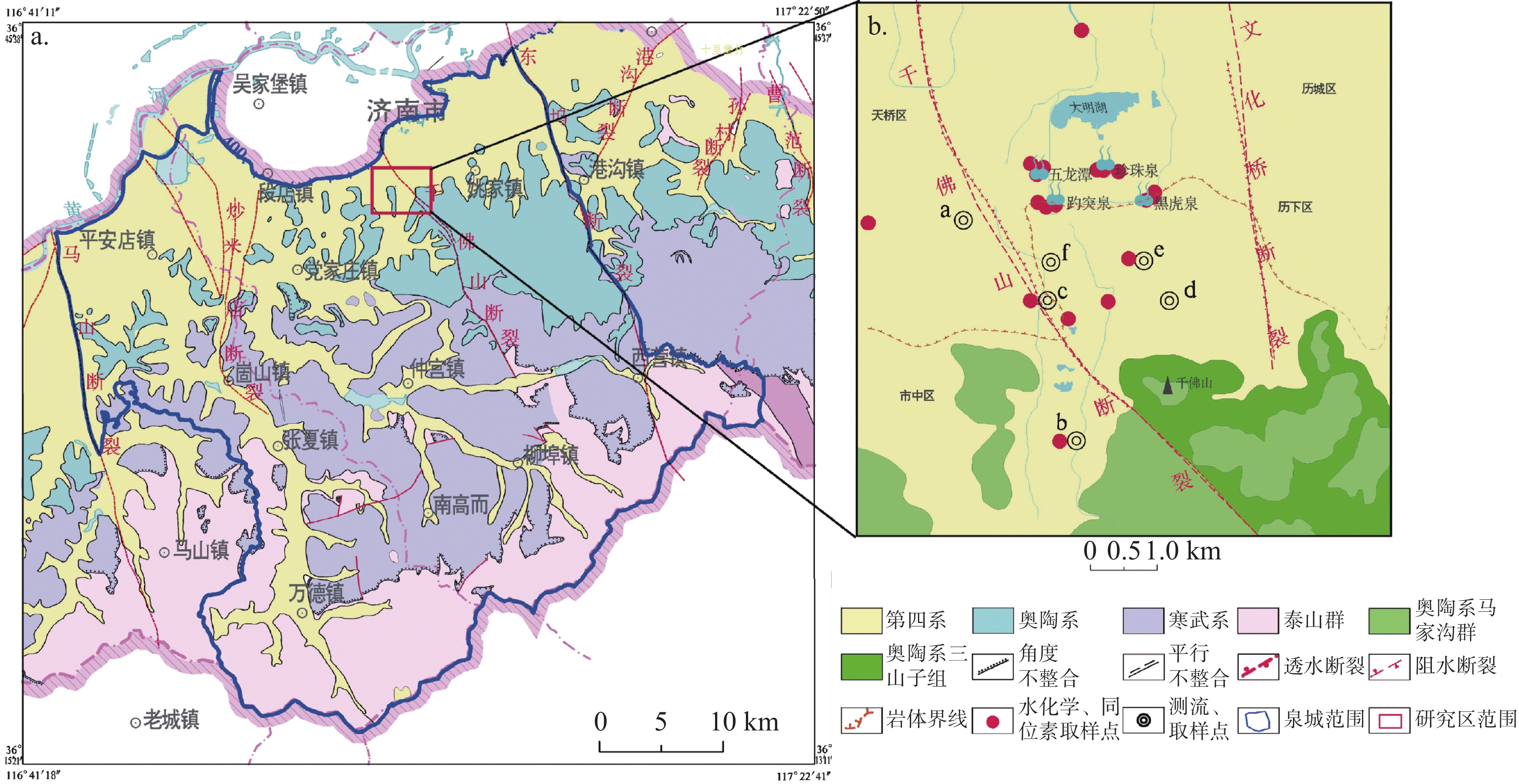Research on recharge paths and recharge ratios near the four major spring groups in Jinan
-
摘要: 济南地区岩溶大泉是集供水、旅游、生态等功能于一体的重要自然资源,但随着经济社会的快速发展,人类活动影响不断增强,各岩溶大泉受到水质劣化、流量衰减的威胁。为了明确济南四大泉群附近主要补给路径,更加科学合理的保护泉水资源,文章采用流速流向定量分析、地下水流场分析、水化学同位素分析、聚类分析、三端元混合比计算等研究方法,分析了济南四大泉群主要补给路径,定量计算了各泉群补给路径贡献比例。研究表明,四大泉群的主要补给路径可划分为西部、南部、东南部补给路径,每个泉群受到不同补给路径的混合补给作用,其中趵突泉、黑虎泉、五龙潭、珍珠泉泉群的主要补给来源分别为南部补给路径(流量占比40.21%)、东南部补给路径(流量占比47.42%)、西部补给路径(流量占比47.13%)、南部补给路径(流量占比51.04%),研究工作可为我国北方岩溶大泉成因机制和生态保护提供参考。Abstract:
Due to its dynamic stability and good water quality, karst water in the northern region of China has become an important water source for urban water supply, and industrial and agricultural activities, providing an important support for economic and social development. Karst springs in Jinan City are also important natural resources integrated with water supply, tourism and ecology. However, since the 1970s, the karst groundwater mining has increased greatly with the rapid development of urban construction; consequently, four major karst spring groups in Jinan gradually dried up and even incurred the cutoff. Until the early 21st century, the four major karst spring groups began to gush again, thanks to the implementation of a large number of ecological control measures. But the water quality of these spring groups is not as good as it was before and the flow is also not large as before. Moreover, there exist ecological and environmental issues such as water quality deterioration, water flow decline, etc. Scholars from around the world have conducted much hydrogeological research in Baotu Spring basin, including the source of recharge of karst groundwater, the cycle of evolution, the relationship between karst cold water and northern geothermal energy, the spatial distribution of karst water-bearing media and flow field characteristics, the conversion relationship of karst water and surface water, etc. However, it is difficult to accurately grasp preponderant runoff paths in karst aquifers at a scale of the hydrogeological unit, which is one of most difficult challenges in the study of karst groundwater. oundwater. The authors are convinced that the analysis of preponderant runoff paths of karst groundwater is prone to be not precise, due to the limitation of spatial accuracy at a scale of the hydrogeological unit. Therefore, in order to clarify the main preponderant runoff paths near the four major karst spring groups in Jinan, and to protect the spring water resources in a more scientific and reasonable way, this study chooses the local area near the outlet of the karst springs as the object, analyzes the preponderant runoff paths of the four major karst spring groups in Jinan, and calculates the contribution ratio of the preponderant runoff paths for each karst spring group by using quantitative analysis of flow velocity and flow direction, groundwater flow field analysis, hydrochemical isotope analysis, cluster analysis, and calculation of the mixing ratio of the three-terminal elements. The study shows that the preponderant runoff paths of the four karst spring groups can be divided into the western, southern and southeastern preponderant runoff paths. Among these paths, the southeastern preponderant runoff path mainly comes from the karst groundwater recharge in the runoff area on the east side of the Qianfo mountain fault; the southern preponderant runoff path mainly comes from the karst groundwater recharge in the runoff area on the west side of the Qianfo mountain fault; the western preponderant runoff path mainly comes from the karst groundwater recharge along the contact zone of gray rock and igneous body in the western suburb of Jinan. In general, water chemical components, and hydrogen and oxygen isotope fractions of these four karst spring groups can be devided into two areas in terms of spatial distribution, namely, the east-west strip distribution area of Zhenzhu spring group and Wulong spring group, and the east-west strip distribution area of Baotu Spring group and Heihu spring group, indicating that the four karst spring groups are subjected to a mixture of different preponderant runoff paths. But even so, the main recharge path of every spring group is different. For example, both Baotu Spring group and Zhenzhu spring group are recharged by the south recharge path with the respective recharge flow ratio of 40.21% and 51.04%, Heihu spring group by the east-south path with the recharge flow ratio of 47.42%, and Wulong spring by the west path, with the recharge flow ratio of 47.13%. The research findings can provide references for the formation mechanism and ecological protection of karst springs in North China. -
表 1 泉水与岩溶地下水水化学组分、同位素组分统计表
Table 1. Statistics of chemical and isotopic components of spring and karst groundwater
分区 统计
参数pH TDS/
mg·L−1K+/
mg·L−1Na+/
mg·L−1Ca2+/
mg·L−1Mg2+/
mg·L−1Cl−/
mg·L−1${\rm{SO}}_4^{2-}$/
mg·L−1${\rm{HCO}}_3^{-}$/
mg·L−1δ18O/
‰δD/
‰水化学类型 趵突泉泉群 均值 7.80 523.33 1.15 25.57 126.78 22.79 56.14 100.50 272.11 −8.11 −58.15 HCO3·SO4−Ca 最大值 7.80 525.00 1.17 26.19 127.19 23.05 56.37 101.39 275.00 −8.10 −57.98 最小值 7.80 520.00 1.11 24.73 125.97 22.41 56.02 99.81 269.22 −8.12 −58.34 黑虎泉泉群 均值 7.47 543.67 1.50 37.26 119.50 22.93 64.17 110.17 269.22 −7.94 −58.24 HCO3·SO4−Ca 最大值 7.50 610.00 1.69 42.74 134.87 25.04 74.45 124.30 292.37 −7.83 −57.53 最小值 7.40 495.00 1.34 30.85 111.02 21.15 54.95 96.88 257.64 −8.04 −58.91 五龙潭泉群 均值 7.53 473.33 0.98 18.49 116.67 21.22 49.40 87.10 263.43 −8.20 −58.81 HCO3−Ca 最大值 7.60 490.00 0.99 19.72 120.16 21.73 52.12 90.78 266.32 −8.18 −58.55 最小值 7.50 460.00 0.97 17.06 112.89 20.76 46.44 82.95 260.53 −8.22 −59.03 珍珠泉泉群 均值 7.50 446.00 1.27 20.92 105.21 19.94 46.44 80.55 248.95 −8.08 −59.01 HCO3−Ca 最大值 7.50 450.00 1.30 21.30 105.81 20.13 46.44 80.69 254.74 −8.08 −58.95 最小值 7.50 442.00 1.24 20.54 104.61 19.74 46.44 80.40 243.16 −8.08 −59.06 西部路径 均值 7.85 329.00 2.08 33.26 56.27 16.83 51.05 49.69 205.53 −8.27 −59.97 HCO3−Ca·Mg
HCO3·Cl-Ca·Na最大值 7.90 390.00 2.99 46.95 56.83 17.74 75.51 56.82 214.21 −7.94 −57.24 最小值 7.80 268.00 1.16 19.57 55.71 15.92 26.59 42.55 196.85 −8.59 −62.70 南部路径 均值 7.75 562.50 1.04 33.03 126.16 20.78 66.65 121.11 276.46 −7.54 −55.41 HCO3·SO4−Ca 最大值 7.90 620.00 1.64 33.55 143.89 21.39 84.02 123.00 306.85 −7.43 −54.75 最小值 7.60 505.00 0.44 32.51 108.42 20.17 49.28 119.21 246.06 −7.64 −56.06 东南部路径 均值 7.36 772.00 1.09 64.04 164.89 29.17 103.66 173.52 337.53 −7.66 −55.86 HCO3·SO4−Ca
HCO3·SO4−Ca·Na
HCO3·SO4·Cl-Ca·Na最大值 7.50 940.00 1.93 98.34 218.04 36.34 119.48 208.93 425.53 −7.43 −54.66 最小值 7.10 600.00 0.54 35.58 141.28 19.81 82.25 143.18 254.74 −7.91 −57.28 -
[1] 袁道先. 我国北方岩溶研究的形势和任务[J]. 中国岩溶, 2010, 29(3):219-221.YUAN Daoxian. The situation and tasks for northern karst research of our country[J]. Carsologica Sinica, 2010, 29(3):219-221. [2] 韩行瑞. 岩溶水文地质学[M]. 北京: 科学出版社, 2015: 2-4.HAN Xingrui. Karst hydrogeology[M]. Beijing: Science Press, 2015: 2-4. [3] Wu X, Li C, Sun B, Geng F, Gao S, Lv M, Ma X, Li H, Xing L. Groundwater hydrogeochemical formation and evolution in a karst aquifer system affected by anthropogenic impacts[J]. Environmental Geochemistry and Health, 2019, 42(9):2609-2626. [4] Gao Shuai, Li Changsuo, Jia Chao, Zhang Hailin, Lv Minghui, Sun Bin, Chen Huanliang, Gang Shiting, Meng Fanqi. Hydrochemical and stable isotope (δ2H and δ18O) characteristics and hydrogeochemical processes in the Baotu Spring basin, Eastern China[J]. Arabian Journal of Geosciences, 2021, 14(20): 2084. [5] 隋海波, 康凤新, 李常锁, 韩建江, 邢立亭. 水化学特征揭示的济北地热水与济南泉水关系[J]. 中国岩溶, 2017, 36(1):49-58.SUI Haibo, KANG Fengxin, LI Changsuo, HAN Jianjiang, XING Liting. Relationship between north Jinan geothermal water and Jinan spring water revealed by hydrogeochemical characteristics[J]. Carsologica Sinica, 2017, 36(1):49-58. [6] Wang Jiale, Jin Menggui, Jia Baojie, Kang Fengxin. Hydrochemical characteristics and geothermometry applications of thermal groundwater in northern Jinan, Shandong, China[J]. Geothermics, 2015, 57(1):185-195. doi: 10.1016/j.geothermics.2015.07.002 [7] Qin Dajun, Zhao Zhanfeng, Guo Yi, Liu Wencai, Haji Muhammed, Wang Xiaohong, Xin Baodong, Li Yu, Yang Yong. Using hydrochemical, stable isotope, and river water recharge data to identify groundwater flow paths in a deeply buried karst system[J]. Hydrological Processes, 2017, 31(24):4297-4314. doi: 10.1002/hyp.11356 [8] 武东强, 邢立亭, 兰晓荀, 孟庆晗, 侯玉松, 赵振华, 孙斌, 袁学圣. 济南岩溶含水介质孔隙结构特征[J]. 中国岩溶, 2021, 40(4): 680-688.WU Dongqiang, XING Liting, LAN Xiaoxun, MENG Qinghan, HOU Yusong, ZHAO Zhenhua, SUN Bin, YUAN Xuesheng. Pore structure characteristics of karst water-bearing media in Jinan[J]. Carsologica Sinica, 2021, 40(4): 680-688. [9] Guo Y, Qin D J, Sun J, Li L, Li F L, Huang J W. Recharge of river water to karst aquifer determined by hydrogeochemistry and stable isotopes[J]. Water, 2019, 11(3):479. doi: 10.3390/w11030479 [10] 管清花, 汪玉静, 陈学群, 曾桂华, 辛光明. 济南玉符河重点渗漏带岩溶地下水补给特征与保护[J]. 中国岩溶, 2023, 42(2): 233-244.GUAN Qinghua, WANG Yujing, CHEN Xuequn, ZENG Guihua, XIN Guangming. Recharge characteristics and protection of karst groundwater in major leakage area of Yufu river in Jinan[J]. Carsologica Sinica, 2023, 42(2): 233-244. [11] 祁晓凡, 李文鹏, 李传生, 杨丽芝, 马瑜宏. 济南岩溶泉域地下水位与降水的趋势性与持续性[J]. 灌溉排水学报, 2015, 34(11):98-104.QI Xiaofan, LI Wenpeng, LI Chuansheng, YANG Lizhi, MA Yuhong. Trends and persistence of groundwater table and precipitation of Jinan karst springs watershed[J]. Journal of Irrigation and Drainage, 2015, 34(11):98-104. [12] 祁晓凡, 李文鹏, 李海涛, 杨丽芝. 济南岩溶泉域地下水位、降水、气温与大尺度气象模式的遥相关[J]. 水文地质工程地质, 2015, 42(6):18-28.QI Xiaofan, LI Wenpeng, LI Haitao, YANG Lizhi. Teleconnections between groundwater levels, precipitation, air temperature of the Jinan karst springs watershed and large scale climatic patterns[J]. Hydrogeology & Engineering Geology, 2015, 42(6):18-28. [13] 迟光耀, 邢立亭, 主恒祥, 侯新宇, 相华, 邢学睿. 大气降水与济南泉水动态变化的定量关系研究[J]. 地下水, 2017, 39(1):8-11. doi: 10.3969/j.issn.1004-1184.2017.01.002CHI Guangyao, XING Liting, ZHU Hengxiang, HOU Xinyu, XIANG Hua, XING Xuerui. The study of quantitative relationship between the spring water and the dynamic change of the atmospheric precipitation in Jinan[J]. Ground Water, 2017, 39(1):8-11. doi: 10.3969/j.issn.1004-1184.2017.01.002 [14] 迟光耀, 邢立亭, 侯新宇, 黄林显, 杨 奕, 张文静. 基于小波分析与Mann-Kendall法的岩溶大泉动态研究[J]. 中国岩溶, 2018, 37(4):515-526.CHI Guangyao, XING Liting, HOU Xinyu, HUANG Linxian, YANG Yi, ZHANG Wenjing. Study of large karst springs using the wavelet analysis and Mann-Kendall methods[J]. Carsologica Sinica, 2018, 37(4):515-526. [15] 郭艺, 秦大军, 王枫, 甘甫平, 闫柏琨. 基于时间序列分析法的岩溶泉水位预测[J]. 中国岩溶, 2021, 40(4): 689-697.GUO Yi, QIN Dajun, WANG Feng, GAN Fuping, YAN Baikun. Prediction of karst spring water level based on the time series analysis method[J]. Carsologica Sinica, 2021, 40(4): 689-697. [16] 孙斌, 彭玉明. 济南泉域边界条件、水循环特征及水环境问题[J]. 中国岩溶, 2014, 33(3):272-279.SUN Bin, PENG Yuming. Boundary condition, water cycle and water environment changes in the Jinan spring region[J]. Carsologica Sinica, 2014, 33(3):272-279. [17] Hosono T, Hossain S, Shimada J. Hydrobiogeochemical evolution along the regional groundwater flow systems in volcanic aquifers in Kumamoto, Japan[J]. Environmental Earth Sciences, 2020, 79:410. doi: 10.1007/s12665-020-09155-4 [18] Geravand F, Hosseini S M, Maghsoudi M, Yamani M. Characterization of karst springs from Zagros Mountain in Southwestern Iran[J]. Environmental Earth Sciences, 2022, 81:529. doi: 10.1007/s12665-022-10645-w [19] Shah R A, Jeelani G, Yadav J S, Rai S K. Hydrogeochemical and stable isotopic evidence to different water origins of karst springs in the western Himalayas, India[J]. Environmental Earth Sciences, 2022, 81:297. doi: 10.1007/s12665-022-10397-7 [20] 蒋文豪, 周宏, 李玉坤, 刘伟, 龚冲, 郭绪磊. 基于钻孔内地下水流速和流向的岩溶裂隙介质渗透性研究[J]. 安全与环境工程, 2018, 25(6):1-7, 18.JIANG Wenhao, ZHOU Hong, LI Yukun, LIU Wei, GONG Chong, GUO Xulei. Permeability measurement of karst fractured media based on groundwater velocity and direction within a borehole[J]. Safety and Environmental Engineering, 2018, 25(6):1-7, 18. [21] 奚德荫, 孙斌, 秦品瑞. 济南泉水研究[M]. 济南: 济南出版社, 2017: 30-40.XI Deyin, SUN Bin, QIN Pinrui. Research on Jinan springs[M]. Jinan: Jinan Press, 2017: 30-40. [22] 徐军祥, 李常锁, 邢立亭. 济南泉水及其保护[M]. 北京: 地质出版社, 2020: 10-20. [23] Piper A M. A graphic procedure in the geochemical interpretation of water-analyses[J]. Transactions American Geophysical Union, 1944, 25(6):914-923. doi: 10.1029/TR025i006p00914 [24] Gao Zongjun, Han Cong, Yuan Shuyu, Liu Jiutan, Peng Yuming, Li Changsuo. Assessment of the hydrochemistry, water quality, and human health risk of groundwater in the northwest of Nansi lake catchment, North China[J]. Environmental Geochemistry and Health, 2022, 44(3):961-977. doi: 10.1007/s10653-021-01011-z [25] Schoeller H. Qualitative evaluation of groundwater resources (in methods and techniques of groundwater investigation and development)[J]. Water Resource Series, 1967, 33:44-52. [26] Craig H. Standard for reporting concentrations of deuterium and oxygen-18 in natural waters[J]. Science, 1961, 133(3467):1833-1834. doi: 10.1126/science.133.3467.1833 -




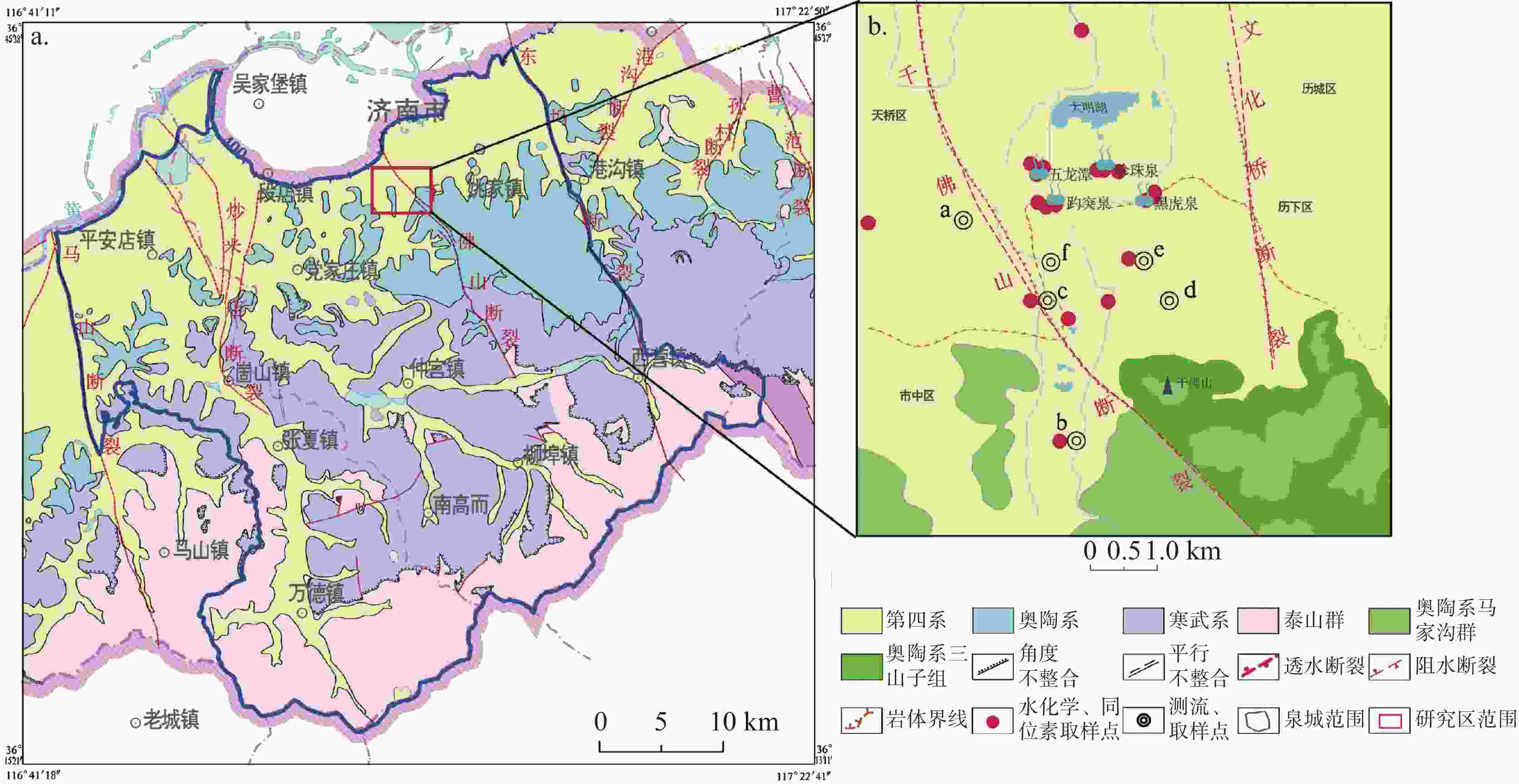
 下载:
下载:
